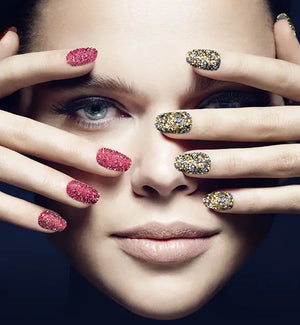
5 Best Diamond Alternatives: Elegant and Affordable
Diamonds have, for centuries, been the epitome of luxury, beauty, and romance - a diamond is a girl’s best friend, right? However, the high price tag and ethical concerns associated with diamond mining have led many to seek alternatives, many of which truly hold up to the sparkle and luxury quality of the real thing.
So, for those looking to retain the dazzle without burning a hole in their pockets, what are the best diamond alternatives available today? In the following article, we’re going go take a look at some stones that come closest to a diamond in terms of sparkle and allure, so you can shine without breaking the bank!
Swarovski Crystals
If you're seeking an alternative that offers unmatched brilliance and clarity, then Swarovski crystals are likely the best diamond substitute. From large Swarovski crystal pendants to smaller crystals used to adorn clothing and furniture, Swarovski crystals are crafted meticulously with precision cuts and facets, and come in an array of designs and sizes.
Plus, their shine is unmatched, and they have the added advantage of being versatile, being suitable for both everyday wear and special occasions. You can browse through an extensive collection of these pendants and crystals at Bluestreak Crystals - we’re one of the few Swarovski Authorised Distribution Partners, so you can be guaranteed you’re getting the real thing when you shop with us.
Moissanite
Moissanite is another gem that boasts immense sparkle and fire; discovered in a meteor crater, it's almost as hard as diamonds and reflects light with an intense brilliance. While slightly different in refractive indices, to an untrained eye, it can be quite indistinguishable from a diamond.
White Sapphires
A popular choice as a diamond alternative, white sapphires bring to the table their own unique charm, and while they don't sparkle as intensely as diamonds due to a lower refractive index, their subtle shine and affordability make them a favourite for many.
Cubic Zirconia
Often cited as one of the stones similar to diamonds, Cubic Zirconia, or CZ, is a synthetic gemstone, and often used to adorn engagement rings and wedding rings. Cubic Zirconia is much lighter than a diamond and isn't as hard or durable, but it does offer an affordable sparkle that can add glimmery luxury to almost any jewellery piece.
White Topaz
This natural gemstone is not only stunning but also offers a wide range of shapes and cuts, frequently used in jewellery making. While softer than diamonds and prone to scratches, when well-cared for, it can be an exquisite addition to any statement piece.
Factors to Consider when Choosing the Best Diamond Alternative
When it comes to selecting the best diamond substitute, here are a couple of factors you’ll want to take into consideration before making your choice:
Purpose
First of all, why are you looking for a diamond substitute? Is it for an engagement ring that will be worn daily or a statement piece for occasional wear, or for a statement-making outfit? Durability will play a significant role here, so opt for the diamond substitute that’ll go the distance if you’re looking for something for long-term use.
Budget
While all alternatives are generally more affordable than diamonds, there's a vast range in price points among them. For example, Swarovski crystals are likely your best bet if you’re looking for the most effective blend of affordability and quality - after all, the Swarovoski crystal is dubbed ‘the affordable diamond’ for a reason!
Ethical Concerns
Some consumers might opt for alternatives due to the ethical controversies surrounding diamond mining; in such cases, synthetic or lab-grown options might be more appealing. Ultimately, it’s up to you to decide if the manufacturing process is something worth considering.
Can you tell the difference between a real diamond and a diamond substitute?
Distinguishing a genuine diamond from a diamond substitute can be challenging, especially for the untrained eye - so don’t worry about someone “spotting” a fake diamond if you opt for a crystal substitute. However, there are subtle differences that professionals and aficionados look for, and that might be of interest if you’re curious about the differences:
Brilliance
Real diamonds have a unique way of refracting and dispersing light, often described as their "fire". While some substitutes like Swarovski Crystals can mimic this effect quite closely, others might not have the same degree of sparkle, or might shine differently under light.
Hardness
Diamonds are renowned for their hardness, ranking 10 on the Mohs scale. Few gemstones can rival this, making scratch tests a common method for differentiation.
Why diamond alternatives are sometimes the best option
So, is it worth opting for diamond alternatives? We certainly think so, and in many instances, they might actually be the preferable choice:
Affordability
One of the most obvious advantages of a diamond substitute is cost; diamond substitutes like Cubic Zirconia or Swarovski Crystals are available at a fraction of the price of real diamonds, making them accessible for a broader audience.
Ethical Considerations
The diamond industry, despite reforms, does remain associated with conflict and ethical concerns, which is why diamond alternatives offer peace of mind for those unwilling to silently participate in these problems.
Environmental Impact
Mining diamonds can be ecologically damaging, impacting vast terrains and ecosystems, while creating diamond substitutes in labs or factories has a significantly reduced environmental footprint.
Durability and Care
While diamonds are incredibly hard and resistant, this doesn’t mean that they’re immune from potential damage. Some alternatives, though softer, might be more resistant to chipping - or might be more easily replaced if damaged given their lower cost.























